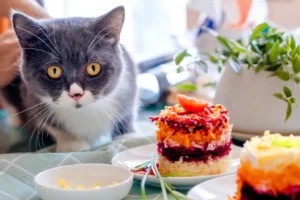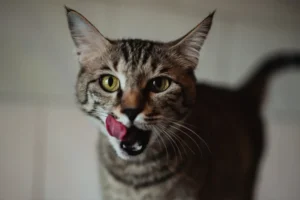You realize there’s a problem when your furry overlord starts looking less like a sleek panther and more like a cuddly, overstuffed pillow. Managing a cat’s weight is less about the catwalk and more about the walk away from the cat food bowl.
In this read, you’ll discover the best feeding strategies that will keep those extra pounds off Kitty’s waistline without turning mealtime into a battlefield.
Key takeaways:
- Assess your cat’s body condition score regularly to ensure they’re at an ideal weight, feeling ribs with a defined waist, not seeing or not feeling them.
- Opt for high-protein, low-carb cat food, and regulate portion sizes with scheduled mealtimes to manage your feline’s calorie intake effectively.
- Integrate play and exercise into your cat’s daily routine to boost their metabolism and strengthen your bond while keeping those extra pounds at bay.
Is My Cat Overweight?
Body condition scoring is like the secret decoder ring to assessing your cat’s weight. It’s a system vets often use, and you can learn it too! The score typically runs from 1 to 9, where a score of 1 means the cat is extremely underweight, and 9 signifies the kitty is, well, a bit too fluffy. Ideally, you want your feline friend to be a 4 or 5, where you can feel their ribs but not see them, and they have a noticeable waist.
If your cat is a little on the rounder side, the risks of obesity aren’t just cosmetic—they’re serious. Overweight cats are at a higher risk for diabetes, urinary tract disease, arthritis, and generally have a poorer quality of life.
Here’s a pro tip: Get handsy with your cat. Give them a gentle rub and feel around their belly, ribs, and back. If you’re having trouble feeling those ribs, or if their belly is swinging more than swaying, it’s likely time for a veterinarian check-up. They’ll give you the lowdown on your cat’s health and confirm whether Fluffy’s been filling out a bit too much.
How Do I Calculate My Cat’s Daily Calorie Needs?
Alright, let’s talk turkey—or rather, kibble. Calculating your cat’s daily calorie needs isn’t always straightforward. Factors such as age, activity level, and current weight come into play. Kittens burn calories like they’re running marathons, while older, lounge-about cats might burn as much as a sloth doing yoga.
For an adult cat, a rough baseline is about 20 calories per pound to maintain weight. But don’t carve this in stone; activity levels can wildly sway that number. A spry one might need more, while your couch potato could need less.
Here’s the thing: to hone in on that perfect number, you’d have to talk to someone who knows their stuff—a vet. They can provide a precise caloric recommendation tailored just for your whiskered companion.
What Kind of Food is Best for Weight Management?
Choosing food for your cat’s weight management is a bit like picking the right pair of jeans. It’s all about the fit and how it suits your furry friend’s specific needs.
Weight management food comes in two main styles: wet and dry. High protein content is what you’re looking for—think of it as the denim of the cat food world: durable and supportive. And low carbs? That’s the stylish cut that makes your cat look and feel good.
Wet food often wins in the satiety department—it’s filling and usually lower in calories, bite for bite, compared to dry food. Plus, the higher moisture content can help keep your cat hydrated and their urinary system in check.
Dry food , on the other hand, has its perks too. It’s convenient and can be better for dental health, as some kibbles are designed to reduce tartar buildup. But here’s the head-turner: it’s often loaded with more carbs, which isn’t ideal for our weight-watching kiddos.
When choosing dry food for weight management, dig around for options with “light” or “indoor” formulae. These often have a tweaked protein-to-carb ratio that aligns better with calorie-conscious diets.
Now, here’s a scoop of insight some might overlook: rotate the proteins in your cat’s diet. This not only keeps Whiskers excited for mealtime but can also reduce the risk of developing food intolerances. Variety can make the journey to a slimmer waistline a little more flavorful!
Remember, we’ve got more coming up, so stay tuned to help your cat prance towards a healthier lifestyle!
How Often Should I Feed My Cat?
When it comes to managing your feline friend’s weight, the debate often comes down to free-feeding vs. scheduled meals. Let’s pounce into this hot topic and scratch the surface to find what’s best for your kitty.
Free-feeding, the practice of making food available to your cat at all times, might seem like the easiest route but it can often lead to overeating and weight gain, especially in less active indoor cats. On the other hand, scheduled meals can help you monitor your cat’s food intake and ensure they’re getting the right amount of nutrition without the excess that contributes to chubbiness.
Portion control is key when scheduling meals. Here’s the scoop:
- Measure meals: Ensure you’re measuring your cat’s food accurately. Use a measuring cup or a scale to provide the correct portions as per the guidelines provided by your vet or the food manufacturer.
- Consistent timing: Feed your cat at the same times every day to establish a routine. This consistency helps regulate their metabolism and hunger cues.
- Split the daily portion: Instead of one or two big meals, consider splitting the daily food portion into multiple smaller meals. This keeps your cat satisfied throughout the day and can prevent begging.
Remember, each cat is unique. The best feeding schedule takes into account their age, health, and lifestyle.
Can Treats and Snacks Still Be On the Menu?
Absolutely! But let’s remember, moderation is the cat’s meow in this situation. Treating your cat responsibly is like walking on a tightrope—it takes balance. Here’s how to do it right:
- Choose wisely: Opt for low-calorie treats. Some treats are specifically designed for weight management, so they’re a better choice for your pudgy pal.
- Keep track: Treats should make up no more than 10% of your cat’s daily food intake. It’s easy to overdo it, so consider keeping a treat log.
- Get creative: Use everyday healthy foods, like a small piece of boiled chicken or a few pieces of their kibble set aside from their daily portion, as treats.
Now, here’s a unique gem: instead of traditional treats, try using a feeding puzzle. These toys release kibble or treats as your cat plays, merging snack time with activity to trim down the waistline while stimulating their brain – talk about a win-win!
But treats aren’t the only way to your cat’s heart. Show your love through affection and playtime – a good chin scratch or a feather wand romp can often be just as satisfying as a snack.
Are There Other Ways to Help My Cat Lose Weight?
Focusing on diet is a huge piece of the puzzle, but it’s not the only one. Cats need to pounce and play—it’s in their DNA. Here’s how to get those lazy cat naps turned into exercise sessions:
- Increase playtime: Engaging your cat in daily play sessions can help burn calories and keep their mind stimulated. Lasers, wands, and interactive toys can entice even the laziest of cats to jump into action.
- Make use of vertical spaces: Cats love to climb. Tall cat trees or shelves can encourage your cat to move more and can provide much-needed exercise.
- DIY Obstacle Course: Create an obstacle course with tunnels, boxes, and paper bags to ignite your cat’s curiosity and enhance their physical activity.
Most importantly, consider these actions as a form of bonding, not just exercise. The extra perk? While your kitty’s shedding pounds, you’ll be strengthening your relationship. What’s better than a happy, healthy cat and a house full of love?
By combining measured and scheduled feeding with responsible treating and a boost in activities, you’re setting your cat on a paw-th to a healthier weight. Remember to always discuss your cat’s diet and exercise plan with your vet, as they can provide tailor-made advice for your furry friend’s unique needs.
Now, go forth and use these tips to help your cat live their fluffiest, fullest life—the scale will thank you!
Alex, a passionate animal lover, has experience in training and understanding animal behavior. As a proud pet parent to two dogs and three cats, he founded AnimalReport.net to share insights from animal experts and expand his knowledge of the animal kingdom.










